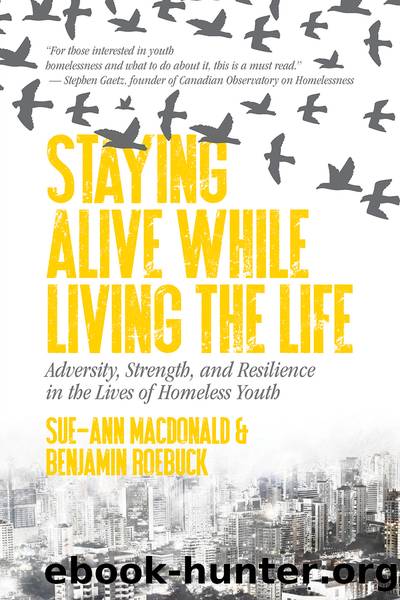Staying Alive While Living the Life by Sue-Ann MacDonald

Author:Sue-Ann MacDonald
Language: eng
Format: epub
Publisher: Fernwood Publishing
Published: 2018-07-15T00:00:00+00:00
6. Evolving Roles and Identities
It made me who I am. You can’t deny that. And if I hadn’t been homeless, things would have been different. Whether it would have been better or worse, I don’t know. It would have just been completely different. (Jean-Olivier, age twenty)
As highlighted in the previous chapters, most youth arrive on the streets with pre-existing histories rife with violence, conflict, instability, and neglect. Youth revealed that their childhoods and their relationships with their families had an enormous impact on their identity and the subsequent choices they made on the streets. Here we draw on theories of adolescence and identity construction that underscore the importance of experimentation and self-discovery. These ideas stand in sharp contrast to traditional views of adolescence as a time of turmoil and growth, in which youth have developmental deficits that need to be overcome in order to form a coherent sense of self (e.g., Erikson 1968; Hall 1904).
Like Bajoit (1999, 2000), we believe that identity construction is continuous and complex and that identity is tied to the past, to the present, and to future aspirations. In this sense, identity is in constant flux, evolving and interacting with different dimensions of life. In the context of this research, identity construction refers to the changing nature of one’s identity as it interacts with one’s perceptions of childhood, current relationships, daily activities, differing roles, and future goals. We also take up Parazelli’s (1997, 1999, 2000, 2002) analysis (borrowing from Winnicott’s 1971 theory) that many street youth use the streets as transitional spaces that allow them to continuously reconstitute their identities by engaging in active role experimentation. It is important to note that this experimentation often takes place within an arena of constrained choices. For many youth, adolescence is a time of heightened risk and sensation seeking. As outlined in previous chapters, street youth are confronted with many paradoxes, such as the search for excitement in the face of danger and the search for freedom within a context of captivity. These constraints all have an impact on the risks youth perceive or are willing to take. Young people’s identities were shaped by the multiple roles they played and the accumulation of experiences that street life offered. For some youth, it was also tied to their attempts to disengage from or exit street life, as noted in previous research (Bellot 2001; Colombo 2008, 2015).
Reshaping Identity
One pattern that emerged in the discussion of personal change was the notion that experiencing homelessness and disconnecting from pre-existing social networks allowed some young people to experiment with their personal identity or to recreate themselves. Pete (age eighteen) described himself as very shy and withdrawn prior to becoming homeless. He explained that his introverted nature had caused him to be bullied in school. During his first night of homelessness, he made a calculated decision to change aspects of his personality that did not seem to be working for him:
And then I’m homeless, and I kind of just changed my ways of doing things overnight.
Download
This site does not store any files on its server. We only index and link to content provided by other sites. Please contact the content providers to delete copyright contents if any and email us, we'll remove relevant links or contents immediately.
Cecilia; Or, Memoirs of an Heiress — Volume 1 by Fanny Burney(31332)
Cecilia; Or, Memoirs of an Heiress — Volume 3 by Fanny Burney(30934)
Cecilia; Or, Memoirs of an Heiress — Volume 2 by Fanny Burney(30889)
The Great Music City by Andrea Baker(21313)
We're Going to Need More Wine by Gabrielle Union(18072)
Bombshells: Glamour Girls of a Lifetime by Sullivan Steve(13108)
Pimp by Iceberg Slim(12931)
All the Missing Girls by Megan Miranda(12747)
Fifty Shades Freed by E L James(12451)
Norse Mythology by Gaiman Neil(11883)
Talking to Strangers by Malcolm Gladwell(11876)
Crazy Rich Asians by Kevin Kwan(8349)
Mindhunter: Inside the FBI's Elite Serial Crime Unit by John E. Douglas & Mark Olshaker(7834)
The Lost Art of Listening by Michael P. Nichols(6472)
Enlightenment Now: The Case for Reason, Science, Humanism, and Progress by Steven Pinker(6405)
Bad Blood by John Carreyrou(5769)
The Four Agreements by Don Miguel Ruiz(5510)
Weapons of Math Destruction by Cathy O'Neil(5036)
We Need to Talk by Celeste Headlee(4868)
